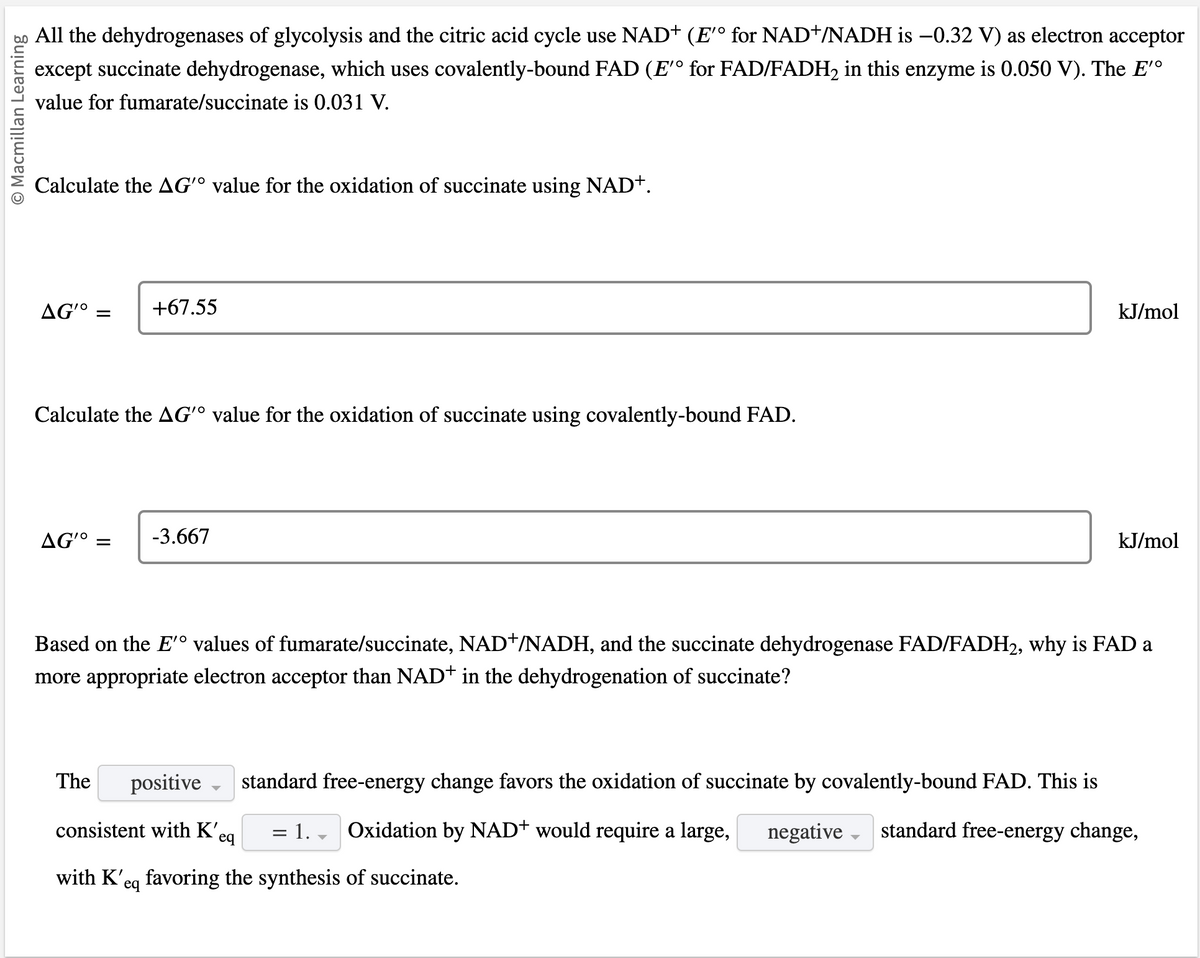All the dehydrogenases of glycolysis and the citric acid cycle use NAD+ (E'º for NAD+/NADH is −0.32 V) as electron acceptor except succinate dehydrogenase, which uses covalently-bound FAD (E'° for FAD/FADH₂ in this enzyme is 0.050 V). The E' value for fumarate/succinate is 0.031 V. Calculate the AG'° value for the oxidation of succinate using NAD+. AG'° = Calculate the AG'° value for the oxidation of succinate using covalently-bound FAD. AG'° = +67.55 -3.667 The kJ/mol kJ/mol Based on the E'° values of fumarate/succinate, NAD+/NADH, and the succinate dehydrogenase FAD/FADH2, why is FAD a more appropriate electron acceptor than NAD+ in the dehydrogenation of succinate? positive standard free-energy change favors the oxidation of succinate by covalently-bound FAD. This is consistent with K'eq = 1. Oxidation by NAD+ would require a large, negative standard free-energy change, with K'eq favoring the synthesis of succinate.
All the dehydrogenases of glycolysis and the citric acid cycle use NAD+ (E'º for NAD+/NADH is −0.32 V) as electron acceptor except succinate dehydrogenase, which uses covalently-bound FAD (E'° for FAD/FADH₂ in this enzyme is 0.050 V). The E' value for fumarate/succinate is 0.031 V. Calculate the AG'° value for the oxidation of succinate using NAD+. AG'° = Calculate the AG'° value for the oxidation of succinate using covalently-bound FAD. AG'° = +67.55 -3.667 The kJ/mol kJ/mol Based on the E'° values of fumarate/succinate, NAD+/NADH, and the succinate dehydrogenase FAD/FADH2, why is FAD a more appropriate electron acceptor than NAD+ in the dehydrogenation of succinate? positive standard free-energy change favors the oxidation of succinate by covalently-bound FAD. This is consistent with K'eq = 1. Oxidation by NAD+ would require a large, negative standard free-energy change, with K'eq favoring the synthesis of succinate.
Biochemistry
6th Edition
ISBN:9781305577206
Author:Reginald H. Garrett, Charles M. Grisham
Publisher:Reginald H. Garrett, Charles M. Grisham
Chapter20: Electron Transport And Oxidative Phosphorylation
Section: Chapter Questions
Problem 7P
Related questions
Question
Check this problem and explain your answer. Especially the fill in the black part at the bottom of page.

Transcribed Image Text:O Macmillan Learning
All the dehydrogenases of glycolysis and the citric acid cycle use NAD+ (E'° for NAD+/NADH is −0.32 V) as electron acceptor
except succinate dehydrogenase, which uses covalently-bound FAD (E'° for FAD/FADH₂ in this enzyme is 0.050 V). The E'º
value for fumarate/succinate is 0.031 V.
Calculate the AG'° value for the oxidation of succinate using NAD+.
AG'° =
Calculate the AG'° value for the oxidation of succinate using covalently-bound FAD.
AG'° =
+67.55
-3.667
The
positive
consistent with K'e
eq
Based on the E' values of fumarate/succinate, NAD+/NADH, and the succinate dehydrogenase FAD/FADH2, why is FAD a
more appropriate electron acceptor than NAD* in the dehydrogenation of succinate?
kJ/mol
=
kJ/mol
standard free-energy change favors the oxidation of succinate by covalently-bound FAD. This is
negative standard free-energy change,
= 1.-
Oxidation by NAD+ would require a large,
with K'eq favoring the synthesis of succinate.
Expert Solution
This question has been solved!
Explore an expertly crafted, step-by-step solution for a thorough understanding of key concepts.
This is a popular solution!
Trending now
This is a popular solution!
Step by step
Solved in 2 steps

Recommended textbooks for you

Biochemistry
Biochemistry
ISBN:
9781305577206
Author:
Reginald H. Garrett, Charles M. Grisham
Publisher:
Cengage Learning

Biochemistry
Biochemistry
ISBN:
9781305577206
Author:
Reginald H. Garrett, Charles M. Grisham
Publisher:
Cengage Learning